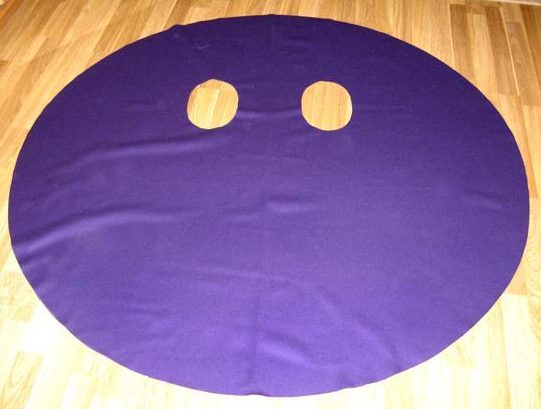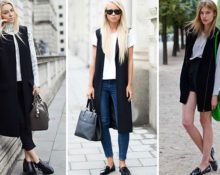 A vest is an indispensable item with the onset of autumn coolness. This is a versatile piece of clothing that not only keeps you warm, but also complements your look, making it more interesting and stylish.
A vest is an indispensable item with the onset of autumn coolness. This is a versatile piece of clothing that not only keeps you warm, but also complements your look, making it more interesting and stylish.
The variety of styles is amazing and makes it possible to choose a suitable vest, both for work and for an informal setting. And warm models made of fur, leather or quilted can be used as outerwear.
The cut of the vest is usually very simple, and if desired, you can sew it yourself.
How to sew an elongated women's vest with your own hands
Most vests are made from a basic dress pattern. To cut it, minor changes are made to the pattern, taking into account the silhouette (straight, fitted), the density of the material, and the presence or absence of lining. There are also original models for which special patterns are created.
Model selection
When choosing a style, you should, first of all, take into account the characteristics of your figure and the purpose of the vest. A properly selected cut will help hide figure flaws and highlight advantages. There are some tips from stylists:
- the classic semi-fitting vest is suitable for almost any body type;
- fitted flared models will balance the silhouette with wide shoulders and narrow hips;
- oversized models are more suitable for fragile, thin girls;
- an asymmetrical hem looks good on rectangle-type figures; the waist will be emphasized by a belt;
- the hem of a dress or skirt should not be visible from under a long vest;
- if the vest is worn under a coat, then it should be shorter, and when the coat is much shorter, then you can wear the vest over it.
One of the most versatile styles is the circle vest. Depending on the fabric chosen, it is suitable for both office and informal settings.
A vest of this style can be worn with or without a belt, and the wide collar can be used as a shallow hood.
But the most important thing: Absolutely anyone can sew it, even those who have no skills. The entire job will take no more than 2-3 hours.
Selection of material and tools
The choice of material depends on several factors:
- season and purpose of the future vest;
- style (business, informal).
 It is better to choose medium-density weave fabrics: suede, boucle, tweed, fleece and any coats. A product sewn from fabric with a fur back will look great. Since the turn-down collar is voluminous, you need to choose a material that looks attractive on both sides.
It is better to choose medium-density weave fabrics: suede, boucle, tweed, fleece and any coats. A product sewn from fabric with a fur back will look great. Since the turn-down collar is voluminous, you need to choose a material that looks attractive on both sides.
You can make the vest double by choosing materials that contrast in color. In this case, it will be possible to wear it on two different sides and easily change the image if desired.
Important! When sewing this model, you should not choose excessively thin fabrics: the drapery of the collar will look bad.
Materials you will need:
- a piece of fabric (size depends on the planned length of the product);
- bias tape for finishing edges and armholes;
- accessories (if necessary).
Pattern construction and cutting
For the pattern you only need to take two measurements:
- Back width. It is measured at the most protruding points of the shoulder blades from one hand to the other. The measurement must be taken exactly along the armpits.
- Armhole height. Measured from the back from the shoulder seam at the base of the neck to the armpit. For convenience, you can mark the horizontal line with a regular elastic band.
The pattern, as is already clear from the name of the model, is a circle. The diameter depends on the desired length of the finished product.

Important! The diameter of the circle cannot be less than the circumference of the hips. Otherwise the vest will look ridiculous.
The location of the armholes affects the appearance of the product: if you place them lower, the turn-down collar will be wider and the vest itself will be shorter.
The armholes are located at a distance equal to the width of the back.
Since the pattern is simple, you can apply all the lines at once to the fabric. But if you lack experience, it is better to first make a cut on a piece of unnecessary fabric. This will give you the opportunity to try it on and, if necessary, adjust the pattern. In addition, it will be easier to draw a perfectly even circle on the base material.
Sewing

After cutting, the procedure is as follows:
- process the edges using an overlocker;
- Cover all edges and armholes with bias tape. Instead of trim, you can use a piece of knitwear, leather, or fur.

If the texture of the fabric is smooth, you will need a button or a belt, otherwise the fabric will slip off and cause a lot of inconvenience.
To sew a double-sided vest, cutting is done twice on different pieces of fabric. To make it easier to process the edges, you will need to pre-baste the parts.
This sewing method is not the only one. There are several options for how you can use this pattern:
- Instead of a circle, you can cut out an oval, then the fabric drapes completely differently, changing the appearance of the vest.
- There is a version of the same pattern, but based on a square. This shape makes it possible to place decorative fasteners and unusual pockets.
- If you place the armholes at an angle on a square pattern, the finished product will have an unusual asymmetrical hem.
- By reducing the diameter you can get a shortened vest.
- Based on this pattern, you can sew an unusual coat in the French style. To do this, you need to use thick woolen fabric and add sleeves to the pattern.
Important! When sewing a coat, the armhole will need to be increased based on the density of the fabric and seam allowance.
An elongated circle vest can be combined with any items from your wardrobe: from a classic pencil skirt to jeans. And after spending just one evening, you can amaze others with an original new thing.



 0
0





